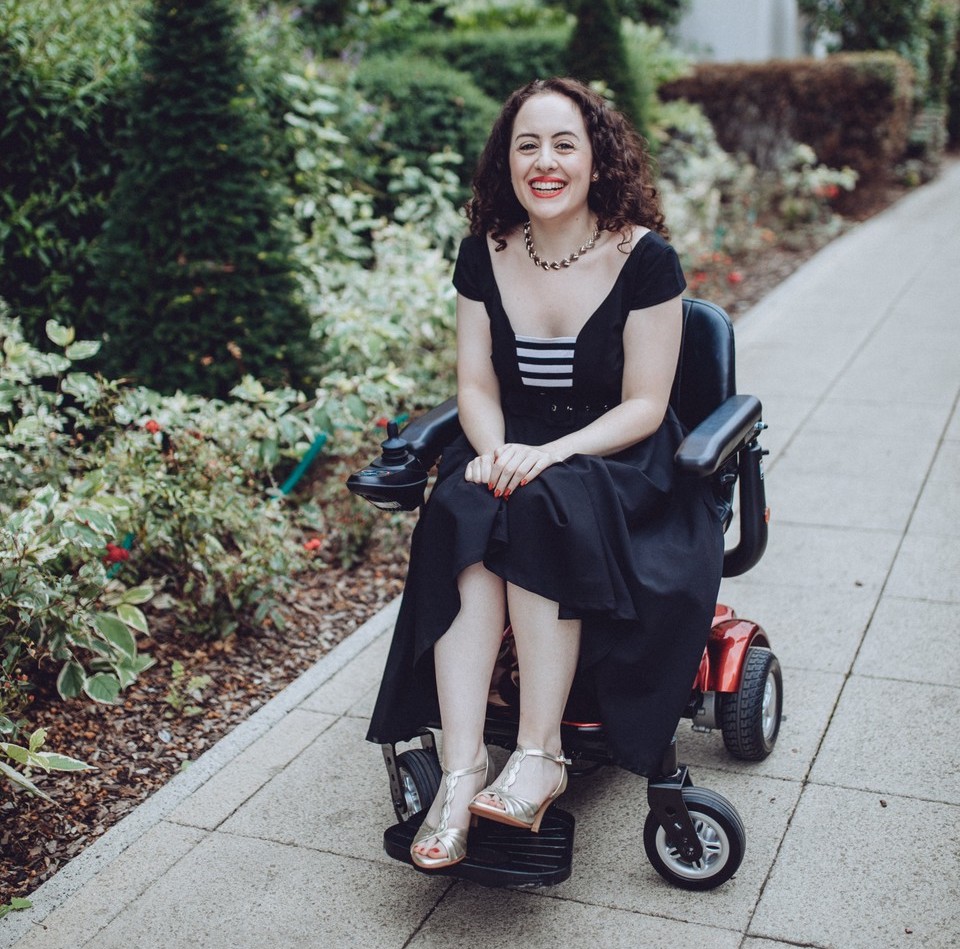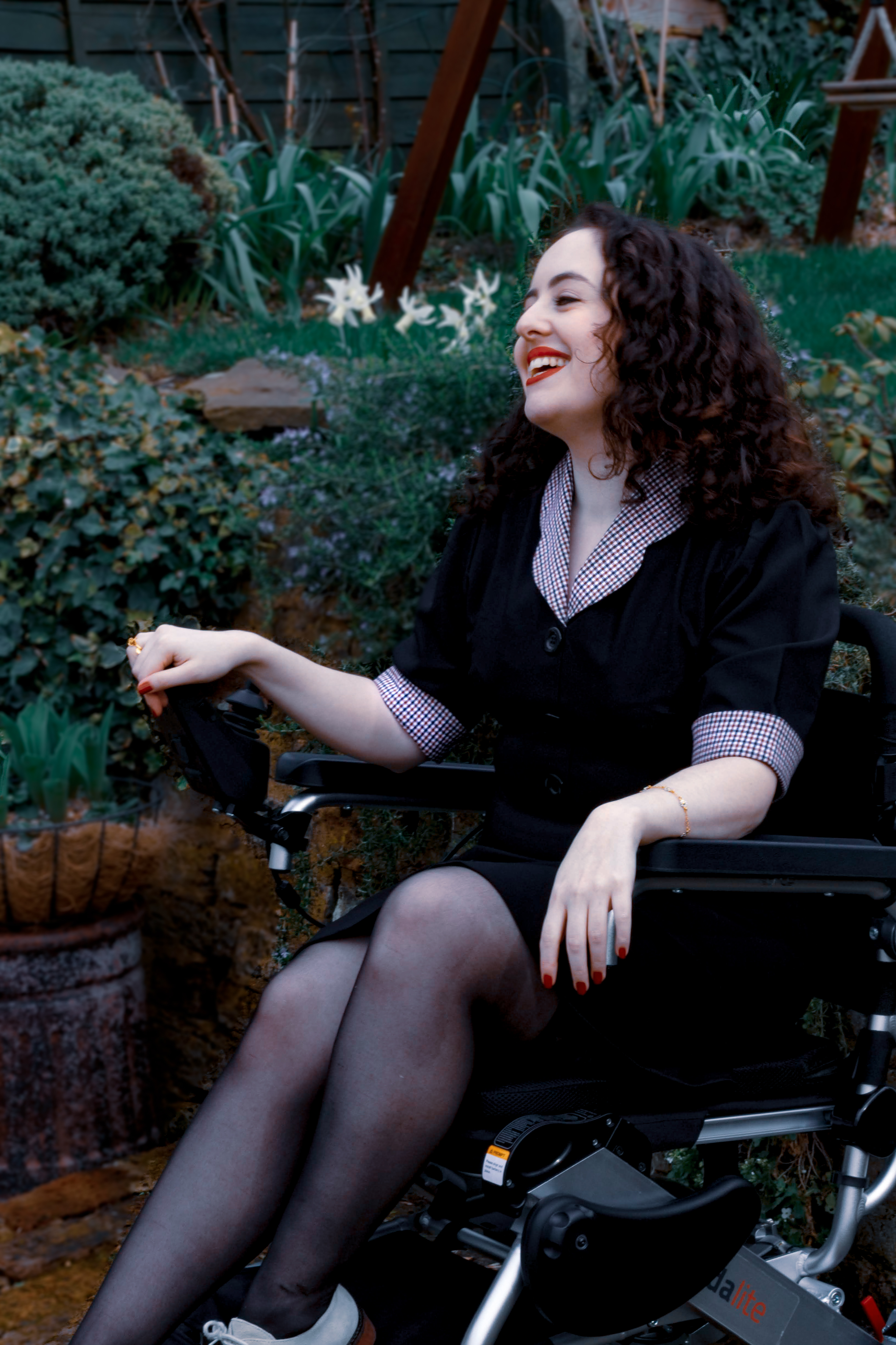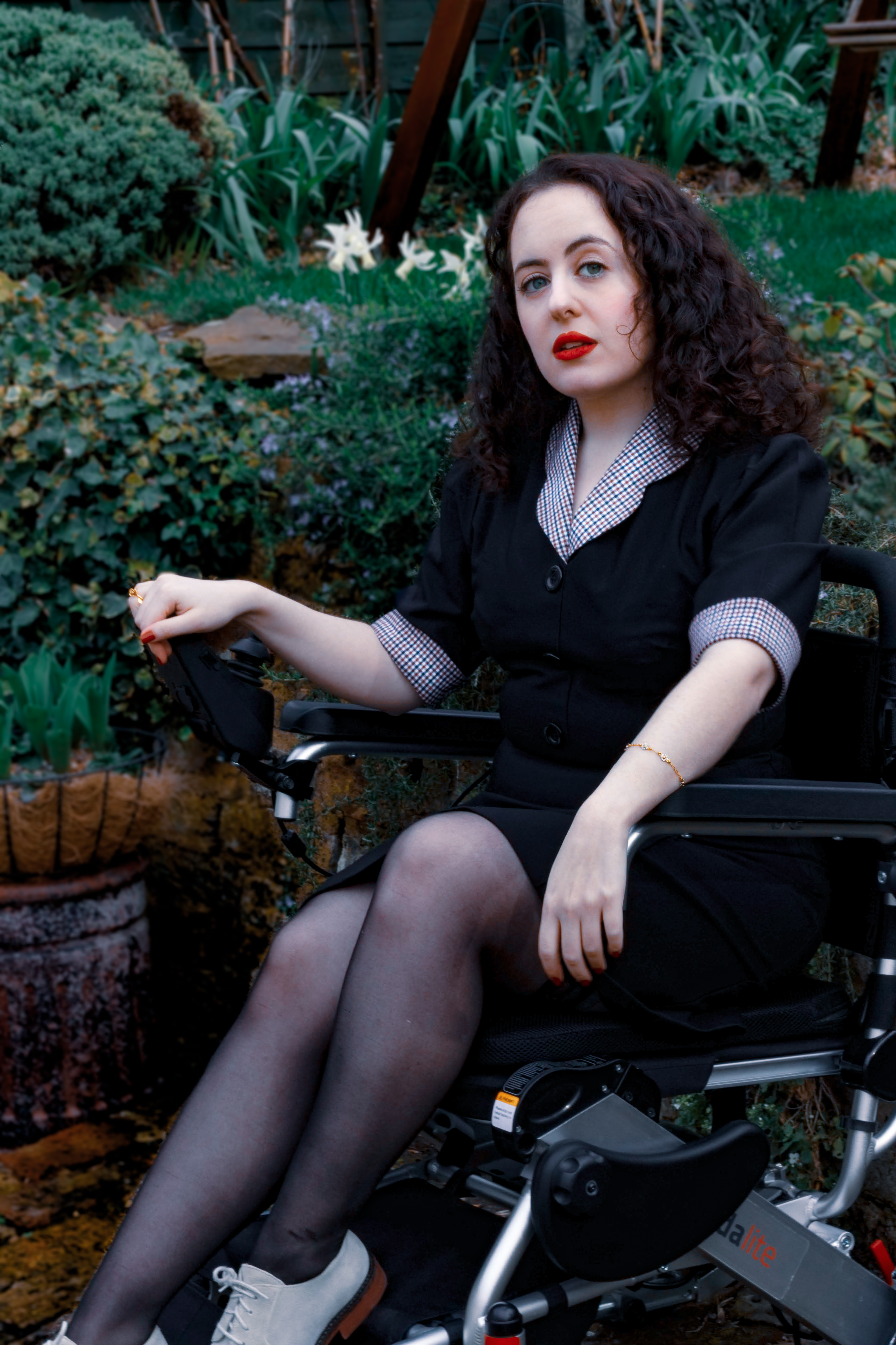It took me a long time to come to terms with deciding to become a wheelchair user, but when I knew that I was ready it was like a switch flicked in my brain. For the first time in years, I had a ‘real job’, and even the few hours a week I went in the office were a significant physical struggle. It was like the push I needed to realise I needed a chair, and looking back I wish I’d let myself get there a year or two earlier. Think of all the pain and fatigue I could have saved myself! But I guess it doesn’t make sense to dwell on what could have been.
Once I made that decision, I had to actually start looking for a powerchair, and it was a daunting experience. The only wheelchairs I had ever used were the awfully big and awfully uncomfortable manual ones you can rent at public places, or my grandma’s old (and super comfy) manual chair that’s made for short people just like me. As much as I liked this chair, it gave me zero independence because I’m unable to self-propel due to issues with my back, shoulders, arms, wrists and fingers, as well as fatigue. Standard.
GETTING STARTED
I genuinely didn’t know where to begin, and most of the information that was available online seemed so targeted at older people that it made me feel incredibly uninspired.
All I knew was that I wanted something transportable, something that wasn’t a scooter, and something that didn’t make me feel ‘medicalised’ in it (no wheelchair equivalent of the ugly grey crutches they give you at the hospital, please!)
Aside from that, I was going in completely clueless.
The chair also needed to be as cheap as possible because I was self-funding. Apparently, if you can walk a few steps in your own home, the NHS doesn’t think you deserve a wheelchair. Because leaving the house and having a life doesn’t matter if you can (sometimes) manage to walk from your bed to the fridge #lifegoals
I felt lucky that the fellow blogger, Tania, had recently been looking for wheelchairs and had written an incredibly helpful guide, which I used as a jumping off point, and she very kindly chatted with me and gave me some pointers.
My first stop was my local disability shop. It was a really, really old shop, that looked like an abandoned medical supplies cupboard at a local hospital. The man in there didn’t make me feel comfortable, and was incredibly unhelpful when I was asking for advice and support since this was a new, scary, decision for me. There was no level of customer service at all, and I just wanted to leave.
I’d found a few chairs that had been of potential interest online, and I took them in, saved on my phone, to use as a starting point for advice. But he didn’t really seem to know anything about them apart from printing off the information I’d already brought in. We obviously didn’t stay for long.
Perhaps I was being naive, but because I’d called to book in a time, I was kind of expecting an ‘assessment’ – measurements, a chat about my requirements and then recommendations. Apparently not.
There was a slightly larger disability chain shop that was also near my house, so we went there afterwards because I didn’t want to feel defeated. When we walked in, I saw a chair that I thought was the cutest little thing. I sat down in it, and it was like that singing angel ‘ahhhhh’ moment. I just knew this chair was for me.
It was the Rascal P321. It was so cute and I wanted it to be mine. It just felt so comfortable. It was my size. And it felt…me? I know that probably sounds silly, but one of the most important elements of getting a wheelchair for me was making sure that I felt comfortable with how I presented. Having been invisibly disabled my whole life, bar a lot of crutches, this was a whole new world I was jumping into. The chair would be the first thing most people noticed, so it had to be one I loved.

But the price was just under £2000, and that was way more money than I could afford. And it turned out that if I ordered it using Motability funding, I’d end up paying several times more the price of the chair and I’d be out thousands of pounds from my PIP. But that’s a whole other, really disgusting, story. Slightly broken hearted, we left.
In the car on the way home, I started Googling to see if I could find the chair for less. The cheapest I could find the chair was on a website of a company that I hadn’t heard of at the time called CareCo. The chair was nearly a thousand pounds cheaper (with the disability VAT exemption, of course), which made it so much more appealing.
A few days later, my dad drove me to their showroom to test out a few other chairs, but I was sure. We argued over getting a folding travel chair, but nothing I sat in compared to how the Rascal made me feel. I ordered it online and a few days later, a lovely man showed up with my chair, showed me how to use it, and I took it for a quick spin in the snow.

NOT QUITE MY DREAM CHAIR
It’s genuinely not an overstatement to say that my Rascal changed my life. It gave me a level of freedom and independence that I’ve wanted since my knees started causing me issues as a child. It was beyond comfortable, looked BLOODY ADORABLE, and also helped prevent my body from crashing so severely after every activity.
But, as much as I loved the aesthetics and the comfort level, there were issues. Billed as a transportable chair, it broke into three heavy, clunky pieces that were a pain in the arse to assemble. It was too heavy to just pick up when we got stuck with access issues, and because it’s mostly an indoor chair, it had terrible suspension that shook me up so much (I didn’t realise this was a chair-specific issue until I used my Foldalite). We were still taking a manual chair when we were travelling, or even going to places in London we knew we’d have an issue (and I’d get grumpier and grumpier because my freedom was taken away every time we did that).
Of course, it’s important to remember that it’s bloody hard to find the ‘perfect’ chair for you off the rack. I now have two chairs that if I combined the features would pretty much make the ideal whole – but those customised chairs are beyond the budget of so many of us and we have to find a way to get the best chair possible with what’s already out there. There are a number of things that I now realise would make my perfect chair, but with my budget and the type of transportability I want from a chair, it’s not something that I’ve been able to find just yet.
As with nearly everything disability related, what we need from a wheelchair can vary dramatically from person to person. We are, after all, individuals with individual needs. There are so many factors, including financial, size, and travel needs, that go into purchasing a chair. As @polkadotspoon said: “one size does not fit all. I’m so used to being “average” that I thought buying off the peg would be fine”.
LESSONS FROM WHEELCHAIR USERS
This post is very kindly sponsored by the lovely folks over at CareCo, who gave me the opportunity to speak with their experts, alongside my blogger pals and Instagram followers to find out what people wished they knew before purchasing their first chair, as well as looking at questions from soon-to-be-wheelchair users.
I want to make it very clear that my experiences, and the experiences shared in this post are those of people living with chronic illnesses. Personally, my main reasons for getting a chair was to help with pain and fatigue. I’m able to transfer by myself, but need help with transportability of the chair. People with different requirements may need different things (I have friends with chronic illness who have super fancy chairs that raise up and tilt and have headrests (that I’m jealous of) and all kinds of other features.
Obviously, this isn’t going to be an exhaustive list of everything and I’m in no way claiming to be the, or even an, expert in wheelchairs, but I do hope it helps you avoid some of the mistakes many of us made if and when you choose to start wheelchair shopping!
THIS IS A BIG DECISION
Please keep in mind that a wheelchair is a big, long-term purchase and is something, where possible, that shouldn’t be rushed.
I’m INCREDIBLY impatient, but I was surprised just how many factors go into finding the right chair, and the impact that the wrong features in a chair could have on my health – especially since I’m not used to sitting, being shaken up, or being out of my bed at all!
So, whilst it’s tempting to buy any chair, it’s worth finding one that fits your requirements as much as your budget, situation, and time-frame allows.
WHAT SHOULD MY FIRST STEP BE?
Ideally, for anyone that needs to use a wheelchair for a significant amount of time, you should have a professional assessment done by a trained occupational therapist or physiotherapist. In theory, you can get a referral for this through your GP, but as I mentioned above, I was rejected even for an assessment because I can (somewhat) hobble around my flat.
The Disabled Living Foundation advises that the key points to keep in mind when considering a chair are: your mobility, your tolerance, your balance, your posture, your height and weight, any skin conditions, and your sight, perception, memory, and cognitive ability, as all of these will play a role in finding you the appropriate chair.
Start your search online, and look at the different ranges of chairs available to get a good idea of the basics and what’s out there. Most sites offer a lot of information on the different types of chairs available, alongside the specifications and details for each individual chair.
There are also a lot of reviews available online, and reading in-depth experiences from other people can help flag things that you may not have thought about before. *insert cheeky plug for Foldalite review*
But, always keep in mind that just because your favourite disabled Instagrammer uses one type of chair, it doesn’t mean that it’ll be right for you. That is why you should…
FIND IT IN PERSON
I know it isn’t possible for everyone to get out to physically look at a chair, but one of the biggest pieces of advice that I was sent over and over again is to actually test the chair out before you buy it. There are so many different chairs on the market and what each of us need is different, so until we actually sit in the chair, we can’t tell whether it’s comfortable for us or moves in a way that works for our lives.
If you are able to test the chair out, don’t just test how comfortable the seat is. Pay attention to how it feels to drive, where your arms sit to control it, where the footrest is, how easy it is for you to get in and out of it, do whether the arms flip up at the side, how easy it is to transport.
Also think about what you want to use the chair for. My Rascal is officially an indoor chair, which means I have a bit of a nightmare navigating anywhere outside that isn’t flat (read: most places). Ask about the suspension and what kind of pavements/kerbs the size of the wheels can handle. If you think you’ll be using the chair a lot (and for long periods of time) pay attention to how long the battery lasts for and how many miles it will take you. Consider whether you can charge batteries externally or not.
Taking this one step further, @lizzieiles on Instagram suggested, if possible, renting the chair you’re interested in before buying to really give you the opportunity to test it out in your home environment (I can definitely relate to the flat surfaces and immediate outside of the shop not giving you all that much of an accurate reflection especially because DROP KERBS AREN’T A THING EVERWHERE, FFS!) and learned more and more over time about how the chair works with me.
Again, the financial issue pops up with this when it comes to buying second-hand powerchairs online. Several people mentioned that they regretted buying a chair second-hand, but for many this may be the only way they’re able to afford a chair at all, so I’d never say do not buy one. But from feedback I’ve received, people have found that the chair hasn’t suited their needs and then couldn’t return it and that the chair was somehow damaged (or didn’t last as long) ended up costing them money over time. Treat it like you’d treat buying anything from eBay – but way more seriously because this is about your health.
If you do decide to go down this route, the Disabled Living Foundation recommends that you “ensure you are given the accompanying literature, an instruction manual and any service history. Look at the general condition of the chair. Look at all fixtures and fittings to ensure that they are present and secure. Check the tyres are in good condition. All seating stitching should also be in good condition”.

SELF-PROPEL OR POWERCHAIR?
Aside from advice, one of the things that came up most frequently on Instagram was from people asking what type of chair they should get .
So much of this is going to be disability-specific (but also just you-with-your-disability-specific), and will entirely depend on both what you’re physically able to do, but also how and when you’re going to use your chair.
There are some conditions where using a self-propelled chair isn’t safe, and some conditions where it’s unsafe to use a powerchair. For me, self-propelling was out of the question, from both a ‘my shoulders like to fall out all the time’ and a fatigue perspective, and because of how I need to hold my arms meant that I found scooters too uncomfortable, too.
And for many people, any chair they buy that’s not customised to them will not be suitable at all.
So, really take some time to think about these things and speak with either your occupational therapist or the staff at the showroom to make sure you find a chair that will best suit your needs.
For anyone who is looking to self-propel, @choosing.amy recommends ultralight chairs as “WAY easier’ “to propel and self-propel than standard chairs.
SPEAKING OF FINANCIAL IMPLICATIONS
When I asked the team at CareCo what they thought the biggest mistake people make when looking to find their first chair, price came up top.
“I think that the biggest mistake customers make is by looking online at the cheapest wheelchair. We regularly have customers coming in to look at a wheelchair because of the price. Nine times out of ten the wheelchair is not suitable for the customer, due to either the weight of the chair, the size of the wheels or comfort”.
Of course, I’m not telling you to go outside of your budget or splurge on the most expensive chair in the showroom, but it’s worth going in with an open mind (within your budget!) because the cheapest chair just may not be suitable for you and your needs, and in the long-run may cause more harm than good.
Don’t forget that if you’re disabled or have a long-term condition, you’re entitled to VAT-exemption, which on my Rascal saved £220. Read more about this here.
HOW WILL YOU transport?
One of the most important questions to keep in the back of your mind is ‘how will I transport my chair?’
Some wheelchair users have the upper body strength to get their own chairs in and out of a car, or manoeuvre it themselves when travelling, for example. Others can’t. Some of us are lucky to have people with us when we’re out, some people don’t always have that available (and obviously don’t always want that, either).
For me, this comes into play a lot, as I’m unable to fold or lift either of my chairs myself, and am therefore entirely dependent on my dad and boyfriend for transportability. But this was a choice, a) knowing that I have no ability to lift anything like that anyway, and b) I very very rarely venture out of the house alone because it’s not something I feel able to do just yet.
Keep in mind whether you’ll need to be able to maneuver the chair yourself, whether it’s something you, or someone else, will be able to lift, and how it folds/comes apart. One of the biggest issues I faced with my Rascal was the transportability aspect of it and the weight, and that’s even considered to be a lightweight and transportable chair.
@keda.with.the.lovely.lesions shared why this is so important: “I’ve had my powerchair for months but I haven’t been able to use it anywhere past my parking lot because lifts and ramps are expensive”.
THINK ABOUT STORAGE
My lovely blogger pal, Pippa Stacey wishes she’d thought about where the chair would live once she got it home:
“On a practical level, give some thought to storage and maintenance beforehand. Is there somewhere accessible you can keep the powerchair when you’re not using it? Will you need to be able to lift and carry the battery yourself when it needs charging up?
I wish I’d given more thought to this before my power chair arrived. I live in a flat but as the building isn’t accessible, my power chair lives in the communal shed outside. There’s no electricity in the shed, meaning I have to carry the heavy battery to and fro myself when it needs charging. Fortunately, there are lots of useful accessories that can make things just a little easier.
Have a look at your power chair provider’s shop or website and see what they can offer: I personally use a weatherproof sheet to cover and protect my power chair when it’s being stored (along with a lock for security), and a sturdy backpack helps me to transport the battery from A to B… definitely something to take into consideration if you too are dealing with chronic fatigue!”
And even if your building is accessible, @awkwardface recommends that you pay attention to whether you can get it through doors, as some chairs can be super wide!
AND WHILE WE’RE AT IT…A BATTERY BONUS
11 months after purchasing my Rascal, it died. Like to the point where it literally wouldn’t turn on. I’d not used it for a while because I’d been travelling and was then super ill, so it had been sitting cosily tucked between my wall and my sofa waiting for the day I could sit in it again. And then…I coudn’t.
Turns out that even if you’re not using a wheelchair, you need to charge it regularly to keep the batteries in good condition. Apparently this is an issue a lot of people run into, and if you’ve got a chronic illness that keeps you indoors a lot, it’s definitely worth keeping in mind, because replacing batteries is expensive a f!
I was able to speak with the lovely Mariah on the CareCo helpline, who was so incredibly helpful throughout the whole process and kindly sent me their battery maintenance guide to share with you, which I’ve uploaded and you can find here.
It’s definitely an irritating thing to think about, especially because it’s rare that I’m even out once a week in a chair, but it’s a habit worth getting into for sure.

AND SOME EXTRAS
So, you’ve got your chair and you’re all ready to go. Now’s the time to think about the little extras that will make your chair more comfortable. For me, my Rascal seat is actually my favourite thing to sit in full stop, but I have a super soft and cosy sheepskin seat cover for my Foldalite that I got at a Christmas market in Germany. I also have a blanket to keep my legs warm and a Bundle Bean to keep me dry.
@elisaterrestrial and @lisa.marie.johanna both made the excellent point that it’s worth investing (if you’re able to) in a good wheelchair seat cushion. This is especially important if you struggle with sitting. I know people who have cup holders, waterproof casings to protect the electronics on their chair (or use a cheeky sandwich bag/rubber band combo), mudguards, crutch holders, charging ports, umbrellas, and much more.
There’s actually a fair amount out there, including bags that are made specifically with wheelchair users in mind, so that’s something else to think about when purchasing your chair, as there may be some extras you can get that will help further adapt it to your needs. Again, it’s definitely worth seeking advice and guidance on this.
TO WRAP IT UP
I really hope all of this has been helpful. As I said, it’s probably far from exhaustive, and if there are any things I’ve missed, or experiences you’ve had, please do leave them in the comments below. Thank you so much to everyone who responded to my request on Instagram, and to CareCo for sponsoring this post! If you liked this post, please subscribe to my newsletter!
One thing I’ll leave you with: a lot of people also mentioned (and I’ve written a lot about this too!) that buying the chair is just the beginning. There’s a steep learning curve in terms of both driving the chair, but also learning about accessibility and getting out and about.
Here are some small pieces I’ve written about some of these topics that may be helpful:
- Wheelchair Q&A
- Do I ‘deserve’ a wheelchair?
- Things no-one tells you when you become a wheelchair user
- Gaining confidence as a wheelchair user
- Will I decondition if I become a wheelchair user?
- My love/hate relationship with my wheelchair
- How I keep warm in my powerchair
- It’s ok to not want to use a wheelchair



5 thoughts on “Things I Wish I Knew Before I Bought My First Powerchair For Chronic Illness”
Natasha, there is a lot to learn when you have to use a wheelchair. If I had to use a wheelchair and I wanted to go out of my house, I would want to have somebody to help me because there would be no way that I would handle a wheelchair.
Hi Natasha,
Good information in this posting. I have used two scooters and three power chairs. All borrowed from the local seniors’ centre in Victoria, BC, Canada. That has been a good way to find out what works for me. Trying them out is very useful.
I will eventually buy one on insurance, but not now while I have an indeterminate loaner that works for me.
A
~
LOVED THIS NATASHA! Even for someone who isn’t going for a powerchair right now, this has been helpful! I have my manual fitting on Monday (eek!) & this has solidified all the decisions. Even though I’ve already tried out 5 already, I’m trying 2 more, just in case!
Also when going to talk to them, ask if certain features/functions/options can be upgraded or retrofitted in the future.
Also, you look FAB in these pics!
xx
It was amazing. Thank you for this lovely information. It is very informative and useful for me. Keep sharing.
In the event that I needed to utilize a wheelchair and I needed to leave my home, I would need to have someone to help me in light of the fact that there would be no chance that I would deal with a wheelchair. It is exceptionally instructive and helpful for me. Thanks for the share.